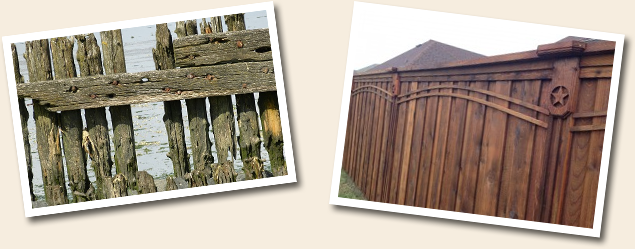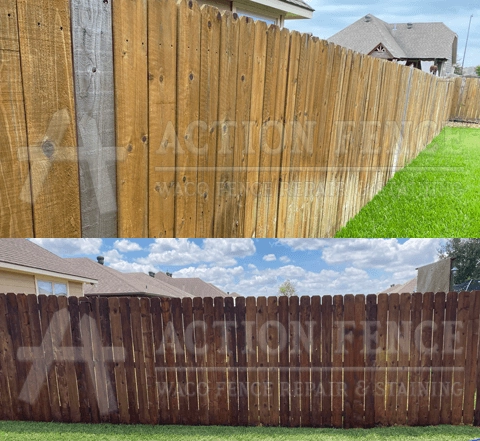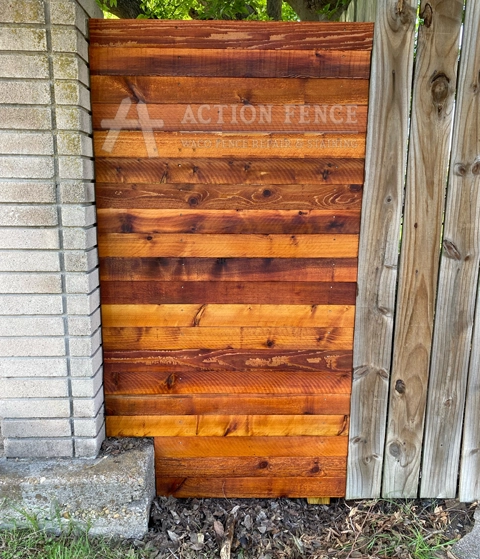Fence Staining Services
As Shakespeare famously said, "a stained fence sure helps fend off Texas humidity, yes siree Bob
." Staining your fence extends its life, possibly by many, many years.

Most fences you'll see around Waco have pressure-treated pine or cedar pickets. Either of these woods can be stained: staining offers extra protection and makes your fence and gate look much nicer. It's a rare case of beauty AND brawn. So, should you stain your fence? This page helpfully goes over the pros and cons.
Call or text (650) 302-0984 with any questionWhat is fence-staining?
Fence stain is a special kind of paint applied or sprayed on the wooden parts of your fence. Staining your fence mainly does two things: first, its sealant properties help repel moisture. That's important: moisture is what leads wood to rot. Second, good quality stains also protect your fence from the long-term damages of UV-rays.
Here are two photos found on Google Images. The fence on the left is not stained, and the fence on the right is stained. The difference is striking: 
Three fence-staining options
You can apply three types of stains to wooden fences. Note that we only use high-quality oil-based stains, not the cheaper water-based variety.
- Transparent staining helps protect your fence but without really affecting its appearance. Your fence will last longer, but will look like an unstained fence.
- Semi-transparent staining accentuates the knots and line pattern of your pickets: it sort of "nudges" the color in a certain direction (red, brown, gold, etc.)
- Solid-color staining actually changes the color of your fence. It's a bit like painting your fence, but you still see the grain of the wood. It's your option if you want a bold color. Color stains last for years without discoloration. The harsh Texas sun takes its toll on stained fences, but quality stains include UV protection.

And unlike regular paint, the stain on your fence won't chip over time. It's fully absorbed by the wood when it's applied, and will only fade to a lighter shade.
Call or text (650) 302-0984 with any questionTo stain or not to stain
I'm sure Einstein had a beat-up, unstained fence, but he made up for it by inventing cool stuff. You probably won't have time to reshape modern physics, but you could be known as "that neighbor with the beautiful fence
." That's something.
Yes, staining your fence adds a one-time upfront cost to installing a new fence. But this cost pays for itself (many times over) in two ways: first, you'll need to repair or replace your fence less often. Second, your fence will look nicer, for longer.

If you go with pine pickets, know that they often turn greenish over time. Cedar pickets age better, but in a beauty pageant, they'd get an unimpressed "meh
" from the judges. But throw-in a nice, rich stain and BAM! You got yourself a stunner. Remember: one of the first thing people see when they walk by is your fence.
Guess who's house will shine on the market? Yours, because you chose a quality fence and stain by Action Fence. You're the best. In the not too distant future, potential home buyers will drive through your street with a disapproving frown. Then, following a tire screech, they'll prance towards your house with gasps of approval: "Look at this fence, Rob. Just look at it. This is the house of my dreams - oh, let's buy it. But first, let me take a selfie.
" Good luck on the sale: ask for a bundle.
Before and after staining a treated pine fence
Here's a before-and-after of a pine fence we stained in summer 2022. Notice that the discoloration from the water sprinkler is gone. Although Waco has some of the softest water in the state (41 PPM), Texas is notorious for having hard water. That high mineral content takes its toll on organic matter like wood fences. We power-washed the fence and applied a dark walnut, oil-based stain. Look at this change! 
Natural-tone or transparent stains
If you want the added protection of staining your fence but you prefer the appearance of natural wood, here's an example of a cedar fence with a "Natural Cedar Tone" stain by Ready Seal. You can hardly tell that the fence is stained: 
When should you NOT stain your fence?
The main reason for not staining your fence is to keep costs lower in the short term.
Keep in mind that you can still stain your fence later on. Especially if your fence isn't stained, watch out for mold or mildew. That problem can spread quickly, and it's much cheaper to replace one or two posts/pickets if you catch it early.
Bottom line: wooden fences become more porous over time, which leads to rot and splitting. But staining (and re-staining) your fence will prolong its lifespan.
Call or text (650) 302-0984 with any question

